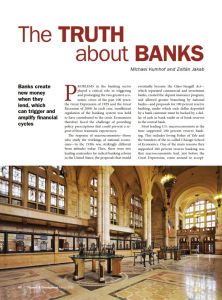Join getAbstract to access the summary!

Join getAbstract to access the summary!
Michael Kumhof and Zoltán Jakab
The Truth about Banks
Finance & Development Magazine, 2016
What's inside?
Banks don’t channel money from savers to borrowers; they create money.
Recommendation
In the wake of the 2008 financial crisis, economists and policy makers have resorted to banking regulatory reform in the belief that new rules will adequately safeguard the financial system. But that thinking lies in part on the conventional wisdom that banks act as conduits to transfer money from savers to borrowers. Yet banks actually create money, as economists Michael Kumhof and Zoltán Jakab explain in this timely commentary. Their viewpoint is not new, just forgotten since the 1930s, but it suggests a fresh approach to economic management. getAbstract recommends this scholarly article to experts in banking, finance and economics.
Summary
About the Authors
Michael Kumhof is a Bank of England senior research adviser. Zoltán Jakab is an economist at the International Monetary Fund.



















Comment on this summary